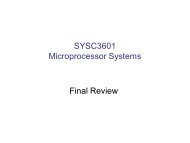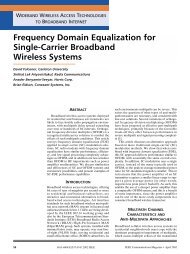Image Reconstruction for 3D Lung Imaging - Department of Systems ...
Image Reconstruction for 3D Lung Imaging - Department of Systems ...
Image Reconstruction for 3D Lung Imaging - Department of Systems ...
You also want an ePaper? Increase the reach of your titles
YUMPU automatically turns print PDFs into web optimized ePapers that Google loves.
initial conductivity x = ∆σ/σ0. For small changes around a background conductivity the<br />
relationship between x and z may be linearized as<br />
z = Hx + n (4.1)<br />
where H is the Jacobian or sensitivity matrix and n is the measurement system noise,<br />
assumed to be uncorrelated additive white Gaussian (AWGN). Each element i, j, <strong>of</strong> H<br />
is calculated as Hij = ∂zi<br />
�<br />
�<br />
and relates a small change in the ith proportional difference<br />
� ∂xj σ0<br />
measurement to a small change in the proportional conductivity <strong>of</strong> jth element. H is a function<br />
<strong>of</strong> the finite element mesh (FEM), the current injection pattern, and the background<br />
conductivity, σ0 . We use the adjacent current injection pattern and a homogeneous background<br />
conductivity with σ0 = 1 <strong>for</strong> each <strong>of</strong> the elements. Normalizing the signal requires<br />
that we also normalize the sensitivity matrix by dividing its columns by vref which is a<br />
vector <strong>of</strong> reference voltages obtained by solving the <strong>for</strong>ward problem [4] over a homogeneous<br />
domain.<br />
4.2.1 Regularization<br />
In order to overcome the ill conditioning <strong>of</strong> H we solve 4.1 using the following regularized<br />
inverse<br />
ˆx = (H T WH + λR) −1 H T Wz = Bz (4.2)<br />
where ˆx is an estimate <strong>of</strong> the true proportional change in conductivity distribution, R is<br />
a regularization matrix, λ is a scalar hyperparameter that controls the amount <strong>of</strong> regularization,<br />
and W models the system noise. Since noise is uncorrelated in the system W is<br />
a diagonal matrix, Wi,i = 1/σ 2 i where σ2 i is the noise variance <strong>for</strong> measurement i. W can<br />
also be modified to account <strong>for</strong> variable gain settings on each tomograph channel. However,<br />
<strong>for</strong> this work we assume that all measurements have equal noise variance, thus W<br />
becomes a multiple <strong>of</strong> the identity matrix. With R = I (labelled RTik) equation 4.2 is the<br />
0 th order Tikhonov algorithm. With R = diag(H) (labelled R diag(H) equation 4.2 is the<br />
regularization matrix used in the NOSER algorithm <strong>of</strong> [35]. [4] modelled R as a spatially<br />
invariant Gaussian high pass filter (labelled RHPF) with a cut-<strong>of</strong>f frequency selected so the<br />
spatial period is a given fraction <strong>of</strong> the medium diameter. RHPF reconstructions appear<br />
reasonable <strong>for</strong> cut-<strong>of</strong>f frequencies corresponding to 5%, 10% and 20% diameter. A 16 electrode<br />
EIT system, using adjacent measurements not at current injection sites, yields 208<br />
measurements <strong>of</strong> which 104 are independent. 104 measurements justifies the recovery <strong>of</strong><br />
104 conductivity parameters which permits, <strong>for</strong> example, the reconstruction <strong>of</strong> a 10 × 10<br />
grid corresponding to a resolution <strong>of</strong> roughly 10%. Thus we consider λHPF <strong>for</strong> 10% because<br />
it appears better justified in terms <strong>of</strong> available independent measurements. All three <strong>of</strong><br />
these priors are smoothing filters, however the Gaussian HPF has the advantage <strong>of</strong> being<br />
mesh size independent in that it is a function <strong>of</strong> the mesh inter-element correlations. Both<br />
Tikhonov and NOSER are ad hoc priors that do not consider correlations between solution<br />
mesh elements.<br />
While several other one-step regularized inverse algorithms exist <strong>for</strong> EIT [18][86][36],<br />
in this paper we consider equation 4.2 with the Tikhonov, NOSER and Gaussian HPF<br />
regularization matrices as a representative sample with which to compare hyperparameter<br />
selection strategies. The hyperparameter selection functions discussed in this paper were<br />
developed primarily with EIDORS [8] and will be contributed to that EIT framework. In<br />
this paper, we do not address issues <strong>of</strong> execution speed or algorithm efficiency as we are<br />
primarily interested in effectiveness <strong>of</strong> hyperparameter selection.<br />
48





